Oftentimes, people who are considering a toucan as a pet tell me, “I know what it takes to care for high-maintenance pet birds. I’ve had parrots for years.” And while I respect the amount of work that’s called for to properly keep parrots, I try to discourage people from believing that having toucans as pets is “just like” having parrots. While there are some basic similarities, it is important to understand that toucans are very different birds with many distinct care requirements that go beyond what is typical for the average parrot.
I have been incredibly fortunate to connect with two fellow toucan ladies, both of whom have much more experience than I when it comes to caring for toucans and parrots and are thus more qualified to make the comparisons for us here. In this interview, they graciously share their insights on keeping toucans as pets and how, specifically, it contrasts with keeping parrots.
Meet Jennifer and Dana
Jennifer Phillips (JP) has worked with animals personally and professionally for her entire life. She was a zookeeper at the LA Zoo and Playboy Mansion, and has also worked as an avian rehabilitator and hand-feeder, a docent at the Bronx Zoo, and in animal husbandry at the California Wolf Center. Jennifer has studied animal training and behavior at Natural Encounters, BehaviorWorks, Dog*Tec, the Academy for Dog Trainers, and Cornell’s Bird Biology Program. She currently works at a veterinary behavior practice, Synergy Behavior Solutions, in Portland, Oregon. In June of this year, Jennifer realized her dream of attending Bob Bailey’s Chicken Camp! In the past, Jennifer has owned budgies, cockatiels, canaries, finches, honeycreepers, and Indian Ringneck parakeets. She has also worked with all types of wild birds including corvids, songbirds, flamingos, cranes, hornbills, waterfowl, and all types of softbills and hookbills. She currently shares her home with two Congo African Grey parrots, one Timneh African Grey parrot, two Green aracaris, and two lovable mutts.
Dana Kozak (DK) is a 40 year old single woman who works as a Project Manager in the aerospace industry. She is a Los Angeles native who has always had a need and desire for animals in her life. In the past, she has owned ravens, finches, lovebirds, Collared aracaris, Chestnut-eared aracaris, and a Swainson’s toucan. Dana currently shares her home with three Collared aracaris, a Blue & Gold macaw, and a Pacific parrotlet.
– – –
What are your general thoughts on keeping toucans as pets?
JP: Green aracaris are very gregarious and can be extremely charming pets! Still, it’s important to realize they are not domestic animals like cats and dogs, they can be difficult and expensive to keep, and they may display less than desirable behaviors seasonally. Their requirements may be more than what the average bird owner is willing (or even has the capacity and resources) to deal with.
The first consideration in keeping toucans is housing. Aracaris need space for flight and room to hop from branch to branch. I would not recommend clipping the wings on toucans or aracaris. I currently house my two Green aracaris in an 80in x 40in x 74in flight cage.
While I understand the reasons why pet owners clip parrots’ wings, I don’t think those reasons are justifiable with a Green aracari or any other toucan. The allowance of free flight in a home has serious safety considerations – open toilets, ceiling fans, glass windows, and other household pets are all potentially deadly hazards.
While it is true that the smaller Green aracaris do not constantly scream like a macaw can, they can be extremely noisy and have high decibel contact calls. The larger toucan vocalizations vary: Tocos tend to “croak” more than Swainson’s, who have a very high-pitched warning call (as do Collared and Chestnut-eared aracaris).
DK: This is probably the worst question to ever have to answer. For me, I don’t believe that it is really a why/why not or a should/shouldn’t. The thing is, with all of the challenges that it takes to keep toucans, you end up having to adapt to them, not the other way around. If you’re not willing to do that, you’re in for a world of hurt as a toucan owner. Trust me, I used to have a normal life before toucans… I wish I could say the same now!
Here are just a few thoughts on toucans as pets, starting with the most obvious:
They fly incredibly fast. It can be quite surprising just how fast they can be, especially when they decide to fly at someone’s face. And this WILL happen. These are not good birds to have around kids – someone will eventually lose an eye.
Cleaning up after them is a challenge. They sling fruit everywhere while they eat. And since they are the kind of birds that have to eat frequently throughout the day, it’s pretty much sunrise to sunset that itty bitty pieces of fruit are flung onto walls, windows, floors, and cage bars. Sometimes it can even hit the ceilings. Cleaning dried fruit off of these surfaces is not only difficult, it can also be very destructive.
They will also find and eat anything they come across, which can literally just shred their digestive systems and kill them. Unlike parrots, they don’t know what they’re eating. Even something as simple as a staple – if found and swallowed by a toucan, they’ll die. You have to be very careful with everything in the house around these birds. Years ago, I had an issue with one of my current Collared aracaris. I noticed that she hadn’t been eating for most of the day. When I took a closer look and examined her, I realized she had swallowed one of my hair ties, and it was lodged down her throat. These things can and will happen. In that case, I was lucky it was just a hair tie and not an earring I had lost on the floor.
Finding an avian vet that has ever treated or understands toucans can also be challenging. I live in LA, and out of hundreds and hundreds of vets, it appears that there are only three who I can go to, and one of those three is over an hour drive away. Granted, I could go to any avian vet, but the last time I did, I was the one who had to do all the explaining about iron storage disease.
Next thing to consider is the toucan diet from two different standpoints. Availability and quality is the first. I cannot tell you how many times I have been unable to find blueberries or papaya (the main base of their diet) at any given time. During the month of December, I could not find blueberries or raspberries anywhere for weeks – and blueberries equal the quantity of papaya in my birds’ diet. So this leaves me with the only option of papaya, pear, banana, and a little kiwi – for weeks. And one of my Collared aracaris won’t eat pear, so he has only three options of different foods daily (I will explain more about the consequence of this shortly). Then, February came and papaya was not available anywhere. I couldn’t find any for about 2 1/2 weeks. Yes, I can feed other fruits like peaches and plums, but these are sometimes not available either. Not a single one of my birds will touch cantaloupe or apples, so those options are out. Then there’s the quality issue. If I buy five papayas, I will more than likely end up tossing out at least one of them. All the fruit they eat has to be ripe, otherwise they won’t eat it (take a look at my shopping list below, as you can imagine, it just thrills me to have to throw fruit out!).
Feeding toucans is costly. Here’s my typical shopping list for a week to feed 3 Collared aracaris:
5 papaya = $20
blueberries = $18
raspberries = $12
pear = $4
banana = $2
kiwi = $7
mango = $3
Total fruit bill for a week = $66
Understanding the toucan diet is very important too, and I think the significance of this is often dismissed. I’ve had three rescue toucans that have all had serious health issues based mostly on diet as far as I’m concerned. Two had severe gout (missing toes, stumps for feet, loss of tongues, feather loss from having to crawl on the bottom of a cage rather than a perch). All of these issues went away with a simple diet change over the course of a few months, with the exception of the permanent damage, obviously. The last rescue to come into my house has other issues. He never fully grew, his eye color never changed, he’s half the size of a normal Collared, and is the only toucan I have ever seen that self-mutilates. I suspect poor breeding stock may have contributed to this, but moreover, I believe it was the fact that the seller (a backyard breeder) had told the owner only to feed him cantaloupe. So that was his only diet for the first FOUR YEARS of his life. If that was all you had to eat for four years, you’d probably be self-mutilating too. Or suffering from gout.
Is there a difference, in your opinions, to keeping the larger species of toucans as pets in comparison to the smaller species such as aracaris and toucanets?
JP: I can’t speak towards the pet angle… but I worked with large and small toucans at Playboy and EFBG. I found the large toucans to be much more docile, and definitely slower moving than the smaller guys.
Of all the aracaris, I’d only recommend Greens, Collareds, and Curl-Cresteds as pets. Guyanas, Ivory-billed, Chestnut Rumps, etc. usually end in disaster. I have heard of one or two Emerald toucanets that have done well in homes – but only with extremely knowledgeable owners.
DK: Aracaris definitely make better pets, in my opinion, though the larger ones seem to be more docile. Collared aracaris can be a little temperamental, but the Chestnut-eareds and the Curl-Cresteds I’ve met have all been incredibly sweet. The smaller aracaris tend to be more high-strung and don’t seem to remain as tame for as long as the larger aracaris. The Ivory-billed aracari seems to be a perfect example. Toucanets… forget it. They belong in aviaries.
Having had a Swainson’s, I would say that there isn’t really all that much difference besides the size… and the NOISE! The calls he made, which was daily, were deafening. They also need an enormous amount of space.
How is keeping toucans as pets similar to keeping parrots?
JP: They are similar in very general terms: very messy, time-consuming, entertaining, rewarding. They pose the same problems encountered by anyone that wants to keep flighted animals in their home: air quality issues (no Teflon, no perfume sprays, no scented candles, etc.), potential danger from window strikes, ceiling fans, other pets in the home, escape risk, behavioral problems, minimum time outside cages, etc.
DK: It’s night and day.
How is keeping toucans as pets different than keeping parrots?
JP: This is a very difficult question to answer, and so important that current toucan owners need to stress to potential owners. It is VERY different. Also, every type of toucan/aracari/toucanet is different, and each have a unique personality. The watery poop, high expense, and large cage requirements are the obvious detriments. And these are huge considerations to a potential owner. I am at the market several times a week and spend a considerable amount of my salary towards their diet.
My three African Grey parrots live with only me, so they are naturally wary of strangers in the house. They are flighted and have the option of flying away from strangers, which is what they usually do when they don’t feel safe. On the flip side, my aracaris will fly AT danger – including faces. Keep in mind that I do a lot of behavioral work and training with all animals, personally and professionally, but some things will always be a matter of arranging the environment for the animal to succeed, as well as management. If your desire is to have a toucan that happily plays with everyone… realize that a very young bird does not necessarily display the same behavior as a sexually mature bird.
Toucans and aracaris will pick up ANYTHING they can get in their beaks. Unlike a hookbill which may manipulate items with its feet and roll it around in its mouth, my aracaris will just swallow things. Any stray paper clips, nails, screws, loose coins, etc. are all potential hazards.
Toucan play is also very different from parrot play. Parrots like to climb, swing upside down, crawl, shred, and chew. Toucans like to fly, hop, and bash things against perches. Many of my aracaris’ favorite toys are small, flexible items that they can carry in their beaks and crack against the sides of their cage. These toys are constantly ending up covered in poop on the bottom of the cage and must be rotated often. While they aren’t technically shredders, they will occasionally tear at the newspaper on the bottom of the cage. As cavity nesters, they often hammer away at the sides of the cages as if they are trying to hollow out a space. Some owners solve this by providing the birds with a log to excavate. This works well and provides enrichment, but it does promote breeding behaviors that many owners find incompatible with keeping a pet.
My suggestion is for any potential owners to spend time with an aracari or toucan that lives in a home setting before making the commitment. Wipe blueberry poop off the walls, lose a few clothes to stains, see what the management is like with other animals (NOTE: my aracaris are ALWAYS separate from my parrots).
On the plus side, my aracaris are much more receptive to body handling (with no prior training) than my parrots. Members of my immediate family and friends can easily handle the aracaris, while the parrots are more hands-off. Plus, they love to dive down the front of t-shirts. I find this delightful, but I have had houseguests find it a little irritating or otherwise aversive. They also “vibrate” when they are being pet or snuggled which is very charming.
DK: Aside from the things I’ve mentioned above, the cage requirements and toy requirements are very different. Toucans need horizontally longer cages. They can’t climb like parrots do, so the dynamics are very different. The same goes for toys. They need toys they can bash and bang around that can’t be swallowed.
What makes toucans such challenging pets in comparison to parrots?
JP: The top challenges are proper diet, housing, and cost. Depending on where you live, toucan diets can be extremely expensive. To compare: I moved from Southern California (where South American produce is relatively easy to find) to the Pacific Northwest, where it is double the cost for fruit and much less available. For two small Green aracaris, my weekly fruit bill is roughly $60-80+ for fruit, plus Mazuri Softbill pellets and ZuLife gel. I can only order these directly from Mazuri, and shipping can well exceed $60 per shipment (not including the cost of the products).
The toucan diet needs to be made fresh. I know some folks have been able to keep food in the fridge for a few days or freeze it. I’ve never found this to be possible, and my birds will rarely eat anything older than a day – at most. This means chopping fruit twice per day. I visit the market several times a week looking for produce. My parrots are a bit easier to feed as they eat a veggie/bean/legume/grain mash that I can prepare in advance and freeze for a week, plus pellets. I haven’t actually sat down to do the math, but I estimate that the cost for two aracaris is 3-4 times more expensive than what my three parrots’ diet costs.
Also, as toucans do not have a crop like parrots do, they eat constantly rather than just a bowl of food twice a day. Fresh fruit must be available at all times. My two aracaris eat roughly two cups of fruit and pellets per day – all that fruit is partially digested and then pooped out… everywhere.
I’ve heard it said that toucans are less messy. This is both true and false. Toucans do not shred paper and wood toys in the same way a parrot does, but they do fling their wet, sticky fruit on everything. Truly, I’ve found blueberries splattered on the wall, several feet from their cage. Prospective toucan owners need to be prepared for sticky fruit on everything… sticky stuff that stains. My house is a series of splash guards and curtains. While poop is poop, I’ve never found my parrots’ poop on the ceiling or staining the curtains.
Another misconception is that toucans do not bite as hard as parrots. Again, I haven’t found this to be entirely accurate. Parrots – especially macaws and amazons – can produce a truly nasty bite. What toucans have is incredible beak pressure. I’ve had to pry a Chestnut-eared aracari’s beak off fingers, and it was not easy! Plus, aracaris have more of a “fly at your face” tactic. The softbill boards are full of sad stories of toucans and aracaris stabbing wrists, harming household pets’ eyeballs, etc. (A quick word about that: Toucans are generally fearless. If you have dogs or cats in your home, it will be constant management and training to keep everyone safe. My dogs are trained to self-crate or scatter if a toucan lands on the floor – and they can never be left unattended).
DK: They’re more challenging as pets for all the reasons I’ve mentioned above. I don’t have to deal with any of that with my macaw.
Can toucans be housed and/or allowed to “play” with each other safely?
JP: Like parrots, or any bird species, this depends on the individual birds. My aracaris are housed together, though this creates some very difficult challenges during the pre-spring and spring breeding season (they are not breeding pairs). There can be some intense territoriality displayed when two birds are housed in this manner. These birds are FAST. Much faster than a parrot and it can make management hard, if not impossible, for the average pet bird owner.
When I moved from California to Portland, there was a short period of time when my birds had to be housed in a smaller cage. This resulted in severe aggression, and they had to be separated. In their larger cage, they do very well. Again, just remember that by “larger”, I’m talking about a cage that takes up my entire living room.
And again I note, my toucans and parrots are ALWAYS kept separately.
DK: Yes, for the most part aracaris can be housed together. I’ve had four Collared aracaris at the most living together. There was only one in that group that didn’t get along with everyone else. Oddly enough, two of those four are my current Collareds and neither of them get along with the little rescued one I mentioned earlier. The different species, however, tend to not mix at all, at least in my experience. My Collared aracaris have lived with Chestnut-eared aracaris and Green aracaris, and there has never been any positive interactions.
What are some things you can do with parrots that you cannot do with toucans?
JP: Good question, and I’m not sure I can answer this fully. Some parrot owners clip wings or harness their birds and take them out in public. My particular birds find it to be aversive and, after a few attempts, I keep them on my property. The danger of flooding is too much a risk for my particular flock. That said, I know many toucans that visit bird fairs, pose for pictures on the streets, and wear harnesses.
Traditionally, it’s not easy to find a parrot-sitter when you want to go out of town… it’s even more difficult for toucans. My parrots eat a detailed diet of veggie/legume/bean/grain mash, coupled with freshly-cut veggies and pellets, which is difficult enough. Finding someone who will come to your home and chop fresh fruit twice a day for toucans is an even bigger challenge. The same goes for finding an avian vet that specializes in softbills. Avian vets are few and far between – and one that can accurately diagnose and treat a toucan is even rarer.
Do you have any other final notes you’d like to share?
JP: Good breeders will be very selective when placing a toucan in a home. They will stress the challenges of owning a toucan, and will discriminately choose suitable environments for their birds. While I don’t always express things eloquently, I cannot stress how different keeping toucans is from keeping hookbills/parrots. The challenges, costs, and housing considerations are much steeper. If you are willing to go the extra mile, have adequate funds, and are willing to put in the time needed for good husbandry and healthy diet… then a toucan may be the right match for you. As always, before taking on any new animal into your home, do the research, talk to current owners, calculate the food bill, and experience gallons of watery poop!
– – –
Special thanks to Jennifer and Dana for all your insights!
If you’d like to connect with them directly,
you can find them on Instagram as
@ghetto_birdz and @danashawnie respectively.
All the photos in this post were provided by Jennifer and Dana.






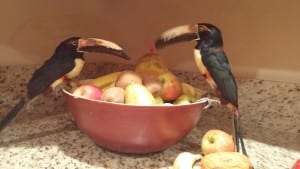
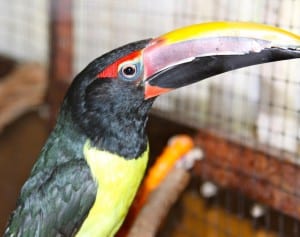
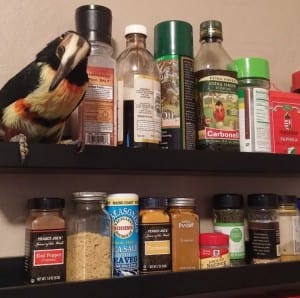
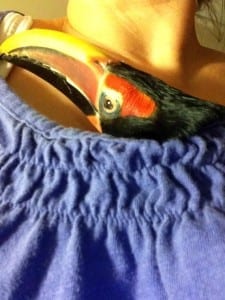
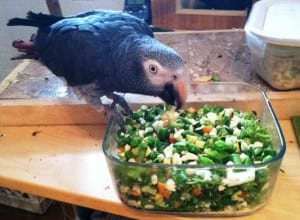
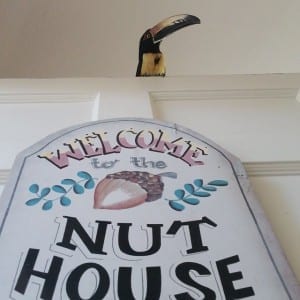
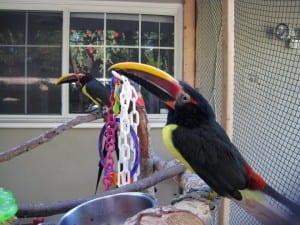
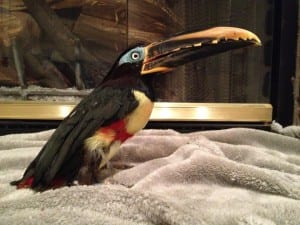


Great write up the Acari. I find that your information is very accurate. Would like to ask for some suggestion/direction. Our ivory bill Acari is getting a bold spot in the back on his body right above the tail area. Everything seems normal and he’s not feisty and still seems happy. He’s shredded in winter time but this seems different as its a bold spot. The pellets that he was eating were changed by the company a few months ago but they are still specifically for soft bills (before it seemed to be more for toucans as they were pictured on the bag). This is the only change. We plan to take him to anew aviary dr this week ( as you mentioned the last one had no idea about acaris and I found myself giving him most of the information). You imput from your experience would be much appreciated as we don’t want it to progress further. Again awesome info! Lorena
I would suggest taking him to an avian pet who specializes in tropical birds. I would also make sure he’s getting plenty of natural sunlight – sunbathing is very important to their overall health.
Pingback: The Future of "Toucanland" | Adventures in Toucanland
Jennifer, I received your article on Facebook and saw that you made a parrot mash that you can freeze. I have a Quaker parrot that I rescued who has a permanently broken leg. I would love to feed him a more healthy diet than just pellets and whatever fruits, grains or vegetables that I am eating any given day. Would you send me the recipe for this parrot mash either by email or Facebook. I would appreciate your help. Thanks. Anne